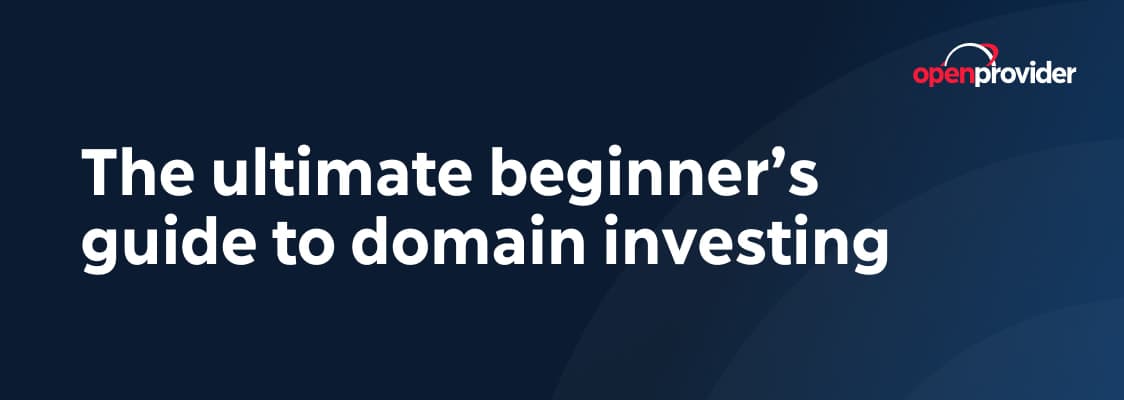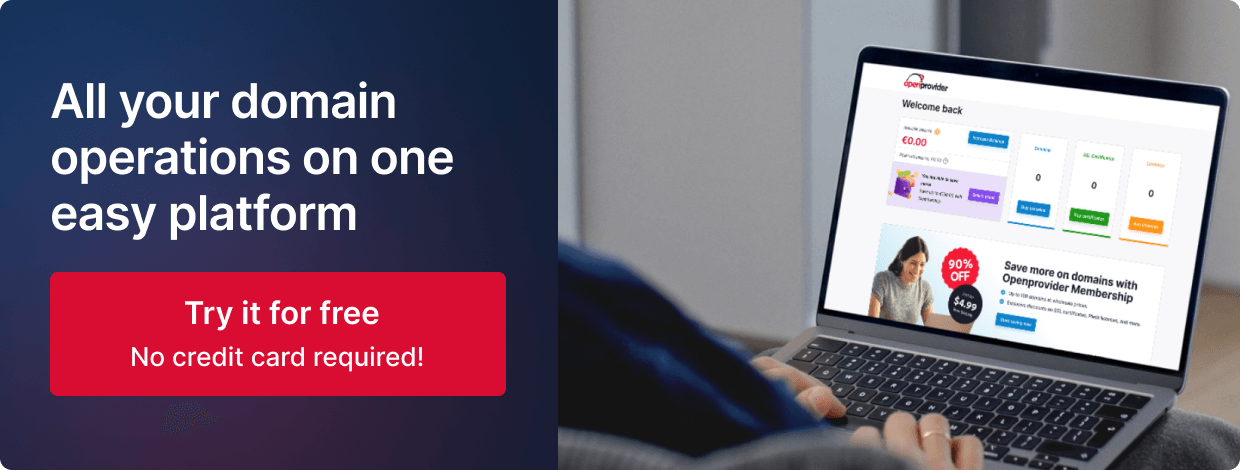Introduction
With over 362.4 million domains registered globally, the domain market continues to show its strength as one of the most dynamic digital asset classes today. While .com and .net still account for 170.6 million registrations, a drop of 1.8 million from the previous quarter shows a potential shift, indicating that alternative TLDs are gaining ground and reshaping the digital real estate landscape.
As per The DNIB Quarterly Report Q2 2024
For digital entrepreneurs, tech-driven investors, and new business owners, this presents a timely opportunity. In this beginner’s guide, we’ll cover the essentials of domain investing: what’s driving the market, where the value lies, and how you can build a portfolio that works for your business goals.
What is domain investing?
Domain investing, sometimes known as domain flipping or domaining, is the practice of buying internet domain names with the goal of reselling them at a profit.
As we’ll see later, domain flipping is actually a specific strategy which fits in the broader, holistic domain investing practice; yet, the goal of a domain investor is to evaluate and choose one or multiple approaches to turn digital investments into profit.
In fact, just like investing in stocks or property, domain investing involves market research, timing, and strategic thinking, where your digital assets are web addresses that people and businesses want.
Types of domain investing
Domain investors typically adopt one or more of the following approaches:
- Buy-and-hold (long-term investing): purchasing domain names expected to increase in value over time. The target domains often include brandable keywords, short acronyms, and niche-specific terms.
- Flipping (short-term investing): acquiring undervalued or expiring domains and reselling them quickly for a profit.
- Parking and monetizing: buying domains with existing traffic and earning passive income through ads or affiliate links.
- Develop-and-sell: building a simple website (such as a landing page or blog) to increase a domain’s appeal and value before selling.
Domain investing is not about luck. It’s about understanding market demand, keyword value, TLD performance, and how trends affect online branding.
Successful investors treat domain investing as a business, complete with risk management, customer outreach, and portfolio planning.
Why become a domain investor?
Domain names are digital assets with relatively low maintenance costs and high potential returns. Here are some compelling reasons to explore domain investing:
- Low entry barrier: you can start with just one or few domains and a small budget, with no need for complex infrastructures or technical expertise.
- High ROI potential: some domains have sold for thousands or even millions of dollars. These might be seen as outliers, but consistent profits are possible with the right strategy.
- Passive income opportunities: domain parking, affiliate linking, or leasing can generate income while you wait to sell.
- Market growth: as more businesses go digital, the demand for short, memorable, and brandable domain names continues to rise.
- Scalability: you can manage hundreds or thousands of domains remotely, with minimal overhead.
Good to know: domain management, at every stage, might sound complex, but modern systems allow investors to perform purchases, registrations, transfers and sales with ease, even for non-experienced investors
Understanding domain valuation before domain investing
Not all domains are created equal.
Just like physical real estate, some domain names command premium prices while others struggle to attract attention: if you want to succeed in domain investing, you need to understand what drives domain value, and how to assess it before you buy.
Domain valuation is the process of estimating how much a domain name is worth on the open market. It combines objective factors like keyword volume and extensions (which follow the domain name and are identified as TLD, or top level domain) with subjective elements like brandability and perceived demand.
Key factors that influence domain value
Some of the most important elements that domain investors consider when evaluating a domain are:
- Length and simplicity
Shorter domain names tend to be more valuable. One-word domains, acronyms, or 2–3 letter combinations are especially in demand due to their scarcity and versatility. - Keyword relevance and search volume
Domains that include popular, high-volume keywords, especially in commercial niches, can attract buyers looking to rank in search engines or run paid ads.
If you want to know more about the selling potential, history and profitability of .ai TLDs, check this article.
- Brandability and memorability
Is the domain easy to pronounce, spell, and remember? Made-up but catchy names can still command high prices if they’re brandable and unique. - Search engine and traffic history
Domains with existing backlinks, indexed content, or direct type-in traffic can be worth more, especially if they’ve never been penalized by Google.
Note: traffic volume, and other important performance metrics are often tracked via specific SEO tools, and they often do not constitute public data.
Moreover, you can explore the history of a domain, its registration information and ownership details using free tools and directories like Whois Lookup, Wayback Machine, and ICANN’s registration lookup.
- Industry trends and demand
Emerging tech, AI culture, or startup trends often influence what domains buyers are looking for. Names related to AI, crypto, wellness, or sustainability have seen spikes in recent years. - Legal and trademark safety
A domain’s value drops sharply if it’s at risk of trademark infringement. Always perform due diligence before acquiring domains that include brand names, abbreviations, or products.
The technical side of domain valuation
Beyond market intuition, domain valuation has a technical layer that involves data-driven analysis, including:
- Search volume and CPC (cost per click): domains tied to keywords with high search intent and ad bidding potential tend to be more valuable.
- Backlink profile and domain authority: historical SEO performance can affect resale price, especially for aged domains with clean link profiles.
- TLD popularity and resale trends: Some extensions have higher historical resale value; to spot patterns and access opportunities related to specific TLDs, you can consult with our experts.
These data points are often aggregated by domain appraisal tools to generate rough estimates.
But while they provide a useful baseline, there’s a difference between machine logic and market-savvy intuition.

AI vs. human valuation
Automated tools like Sedo use ML algorithms that draw on historical sales, keyword metrics, and pattern recognition to assign a value to a domain.
Human valuation brings in context, such as market trends, branding potential, cultural resonance, and negotiation dynamics: a human investor might spot value in a name that algorithmic tools overlook, especially in niche industries or creative combinations.
Thus, it’s important to understand the differences in domain appraisal methods, especially between how evolving AI tools perform, where they still fall short, and when human insight plays a role.
How the human factor is evolving
As AI becomes more sophisticated, human domain investors are shifting their focus. The future of valuation is not man versus machine—but man with machine.
- AI speeds up bulk filtering, helping investors scan thousands of domains for basic value signals.
- Human insight narrows the field, identifying which names have brand potential, regional relevance, or emotional appeal.
- Hybrid tools are emerging, where AI handles volume and humans fine-tune the final shortlist.
Strategies for domain investing
Domain investing encompasses various approaches, each with its own risk profile, time commitment, and potential returns.
1. Buy and hold (long-term investing)
This strategy involves acquiring domain names with the intention of holding them over an extended period, anticipating appreciation in value.
Key considerations:
- Scarcity and demand: short, memorable, and brandable domains, especially those with popular extensions like .com, tend to appreciate over time.
- Emerging trends: domains related to burgeoning industries (e.g., AI, blockchain) can become valuable assets as those sectors grow.
- Patience required: returns may take a relatively short time, as well as years to materialize, and not all domains will increase in value.
2. Domain flipping (short-term investing)
Domain flipping entails buying undervalued domains and selling them quickly for a profit.
Key considerations:
- Market research: identifying trending keywords and industries can lead to profitable flips.
- Negotiation skills: effective communication with potential buyers can expedite sales.
- Quick turnaround: this strategy requires active management and swift decision-making.
3. Domain parking
Domain parking involves monetizing unused domains by displaying advertisements, generating passive income.
Key considerations:
- Traffic volume: domains with existing type-in traffic are more likely to generate ad revenue.
- Ad networks: partnering with reputable parking services can optimize earnings.
- Limited growth: while providing passive income, parked domains may not appreciate significantly in value.
4. Develop and sell
This approach involves building a website or brand around a domain to increase its value before selling.
Key considerations:
- Value addition: developed websites with content, traffic, and revenue streams are more attractive to buyers.
- Time and resources: requires investing in content creation and brand marketing activities.
- Higher returns: well-developed domains can command premium prices.
Big sales shaking the domain world: You.ai sold for $700,000
In October 2023, the domain You.ai was sold for a record-breaking $700,000 through Sedo, marking the highest reported .ai domain sale to date.
The seller, a Chinese investor named Jiupeng, had been investing in .ai domains for over a decade, anticipating the rise of artificial intelligence. This sale underscores the potential of the buy-and-hold strategy, especially when aligned with emerging technological trends.
How to start domain investing (and why Openprovider gives you the edge)
Starting a domain investing journey doesn’t require a large capital outlay or advanced technical skills, but it does require a strategic mindset, market awareness, and reliable tools.
1. Define your investment strategy
The first step is to determine the domain investment strategy that best aligns with your resources and business goals. Are you planning to flip domains for quick profit, hold strategic domains for long-term gains, monetize traffic, or develop digital assets into saleable sites?
Each approach requires specific capabilities. Buy-and-hold investors benefit from tools that help track renewals and market trends. Domain flippers rely on fast registration and streamlined transfer tools. Those focused on development need clean DNS configurations and branding flexibility.
Openprovider supports all models through cost-based domain pricing, robust control panels, and full API access for portfolio automation.
2. Conduct market research
Research is essential to identify which domains are worth acquiring. This includes analyzing trends using tools like Google Trends, evaluating keyword value, studying industry shifts, and monitoring new technology sectors. Look for opportunities in emerging markets, fast-growing verticals, or niche industries.
With Openprovider, you gain access to nearly 2,000 domain extensions, including high-demand and niche TLDs like .ai, .tech, .dev, and many regional ccTLDs. This diversity allows investors to stay ahead of trends and offer domain options that align with changing market needs.
3. Register your domains
Once you’ve identified potential domains, move quickly to secure them. Timing is critical in this space, and registration costs can add up quickly if you’re not using the right partner.
Openprovider Members get all domain operations at cost price—registration, renewals, transfers, updates, WHOIS protection, domain forwarding, and more. This pricing model significantly improves profitability, especially for investors managing larger portfolios.
For those bringing over domains from other providers, Openprovider also offers fully assisted bulk transfers, reducing time-to-value and simplifying portfolio consolidation.
4. Monitor, manage and optimize
Effective domain investing goes beyond acquisition. Investors need to track portfolio performance, TLD trends, buyer demand, and domain health over time. Monitoring traffic patterns, domain history, and SEO profiles can help identify high-value assets and flag underperforming ones.
Openprovider’s Reseller Control Panel and modern API (REST-based) make it easy to manage portfolios of any size. Features include bulk actions, role-based access, transaction logs, automated renewal settings, and invoice tracking. For resellers, platform integrations with WHMCS, Blesta, HostBill and others streamline operational efficiency.
5. Sell, lease, or develop
When it’s time to monetize, consider your exit strategy. Domains can be listed for sale on major marketplaces, leased to businesses needing temporary digital branding, or developed into functional websites or landing pages to boost perceived value.
As an Openprovider Member, you gain access to dedicated account managers, promotional support, marketing enablement resources, and exclusive access to domain campaigns. These benefits support investor growth and provide strategic guidance as your portfolio evolves.
Why choose Openprovider for domain investing
With ICANN accreditation and ISO 27001 certification, Openprovider is uniquely positioned to support serious domain investors through, being the only one providing subscription-based domain services:
- Cost-price (equivalent to wholesale purchases) on more than 3 million domains available
- Automated domain operations across over 1,900 TLDs and fully assisted bulk domain transfers
- REST API access with developer-friendly sandbox environment
- White-label capabilities and DNS configuration options
- Email services and SSLs, especially for resellers and agency owners
Openprovider enables domain investors to start smarter, scale faster, and manage portfolios more profitably through our cost-based membership model, automation-ready platform, and extensive TLD coverage.
Start now with the right membership plan for your needs




